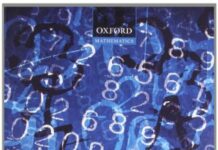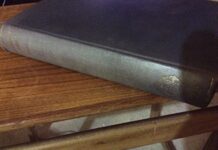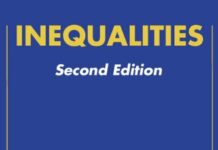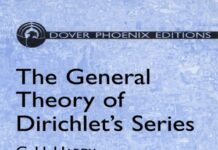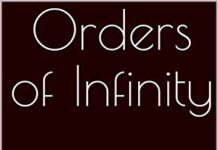
Ebook Info
- Published: 1985
- Number of pages: 456 pages
- Format: PDF
- File Size: 0.47 MB
- Authors: G. H. Hardy
Description
This is the fifth edition of a work (first published in 1938) which has become the standard introduction to the subject. The book has grown out of lectures delivered by the authors at Oxford, Cambridge, Aberdeen, and other universities. It is neither a systematic treatise on the theory of numbers nor a ‘popular’ book for non-mathematical readers. It contains short accounts of the elements of many different sides of the theory, not usually combined in a single volume; and, although it is written for mathematicians, the range of mathematical knowledge presupposed is not greater than that of an intelligent first-year student. In this edition the main changes are in the notes at the end of each chapter; Sir Edward Wright seeks to provide up-to-date references for the reader who wishes to pursue a particular topic further and to present, both in the notes and in the text, a reasonably accurate account of the present state of knowledge.
User’s Reviews
Editorial Reviews: Review “A really good book!”–Fernando Gouvea, Colby College
Reviews from Amazon users which were colected at the time this book was published on the website:
⭐This is an unusual number theory book in that it covers topics of interest to the authors which are not often found in the “standard” introductory treatment. My only mild complaints are: no subject index and some ambiguous and unusual notation here and there.I agree that this book should be in the library of anyone serious about the topic, however, if you are beginning your study of number theory from scratch there are other books that may provide a better start. I would recommend Joe Roberts “Elementary Number Theory: A Problem Oriented Approach” and/or “An Introduction to the Theory of Numbers” by Niven, Zuckerman, and Montgomery.Roberts offers a wide spectrum of problems, with detailed solutions, written along the lines of Polya & Szego’s “Problems and Theorems in Analysis I & II”. Nivens book is a solid traditional introduction.It is fun to read Hardy and Wright though, it exhibits a style that is sadly missing today.I have to say in closing that it would be good to ignore some of the previous reviews, specifically ones making reference to “idiots”. They’re unproductive, miss the point of reviewing, and exhibit a level of ignorance which Mark Twain identified years ago: “It is better to keep your mouth shut and appear stupid than to open it and remove all doubt.”
⭐Faster delivery
⭐Every serious student of number theory should have this classic book on their shelf. Even though only “elementary” calculus and abstract algebra are used, a certain mathematical maturity is required. I feel the book is strongest in the area of elementary –not necessarily easy though — analytic number theory (Hardy was a world class expert in analytic number theory). An elementary, but difficult proof of the Prime number Theorem using Selberg’s Theorem is thoroughly covered in chapter 22.While modern results in the area of algorithmic number theory are not presented nor is a systematic presentation of number theory given (it is not a textbook), it contains a flavor, inspiration and feel that is completely unique. It covers more disparate topics in number theory than any other n.t. book I know of. The fundamental results in classical, algebraic, additive, geometric, and analytic number theory are all covered. A beautifully written book.Other recommended books on number theory in increasing order of difficulty:1) Elementary Number Theory, By David Burton, Third Edition. Covers classical number theory. Suitable for an upper level undergraduate course. Primarily intended as a textbook for a one semester number theory course. No abstract algebra required for this book. Not a gem of a book like Davenport’s The Higher Arithmetic, but a great book to seriously start learning number theory.2) The Queen of Mathematics, by Jay Goldman. A historically motivated guide to number theory. A very clearly written book that covers number theory at a graduate or advanced undergraduate level. Covers much of the material in Gauss’s Disquisitiones, but without all the detail. The book covers elementary number theory, binary quadratic forms, cyclotomy, Gaussian integers, quadratic fields, ideals, algebraic curves, rational points on elliptic curves, geometry of numbers, and introduces p-adic numbers. Only a slight bit of analytic number theory is covered. The best book in my opinion to start learning algebraic number theory. Wonderfully fills the otherwise troublesome gap between undergraduate and graduate level number theory.Full of historical information hard to find elsewhere, very well researched. To cover all the material in this book would likely take two semesters, though most of the important material could be covered in one semester. Requires a background in abstract algebra (undergraduate level), and a little advanced calculus. Some complex analysis for sections 19.7 and 19.8 would be helpful, but not at all a requirement. The author recommends Harold Davenport’s The Higher Arithmetic, as a companion volume for the first 12 chapters; according to Goldman it is a gem of a book.3) Additive Number Theory, by Melvyn Nathanson. Graduate level text in additive number theory, covers the classical bases. This book is the first comprehensive treatment of the subject in 40 years. Some highlights: 1) Chen’s theorem that every sufficiently large even integer is the sum of a prime and a number that is either prime or the product of two primes. 2) Brun’s sieve for upper bound on the number of twin primes. 3) Vinogradov’s simplification of the Hardy, Littlewood, and Ramanujan’s circle method.
⭐First of all, let me say this about the one star review. Do not let yourself be infuenced by lesser mathematicians. Idiots in my opinion. To give this book one star, you must posses some special kind of mediocracy. Keep your stupidity to yourself Lucas.No one writes like this anymore. Mathematicians like Hardy have passed. The subject has ballooned, and now you have to specialize within Number Theory. There are fewer and fewer that can posses knowledge of the entire subject of Number Theory. Remember what Harold M. Edwards said. You have to read the classics, and beware of secondary sources. Authors give their own spin on ideas. And who is to say they have a greater or lesser understanding of the subject. Furthermore, who can determine how well can they express themselves. How many mathematicians our days bother to study grammar and literature? The best example is Gauss’ Disquisitiones Arithmeticae. Would you rather read a book written by Gauss himself, the man that established the subject? Or by some one who learned what some one learned what some one learned over a period of 200 years? Also know what Axler, author of Linear Algebra Done Right, said about reading mathematics books. For a mathematics book, if you spend less than half an hour per page you are going too fast. The last thing i will say is again attributed to Edwards. In his book on Advanced Calculus he encourages the reader to jump chapters. A book does not have to, and sometimes it should not, be read in order. It may take some practice to see how you need to jump around, but you will find that you can maximize your reading by doing so.There are several point in which this book excels. First, in the writing style. Second, in how many ideas it introduces. Or how good an understanding the reader obtains of Number Theory. It is invaluable to have the big picture. Third, the author has in mind the future material the reader will encounter. He knows you will go beyond this book, and prepares you for what is to come. You do not enter higher courses blind.The writting style is representative of that of Wiles and Loiville. It will show you how your mathematical writting should be. It takes a lot of practice to learn mathematical formalism and how to write proofs. This is the book to learn from. The author is not afraid to connect the ideas you are learning to other advanced ideas and to mathematical history, unlike present day authors. If you plan to be a mathematician, you must know its history. The writting is in a mathematical sense superfluos. It does not assume you are a genius, but strikes balance between what you should know and what you should be told.The book is successful in providing you with the big picture, and how ideas you are learning reflect one ideas you will learn or have already learned. Having a big picture of the subject, which he describes in the second chapter, lets you know what you are learning now and puts the entire material in context. Gives you great perspective of the subject. Because a great deal of branches of number theory are discussed, you are not only better equiped to choose which branch might interest you, but it eases the transition to more advanced courses, such as Analytical Number Theory.The author from the start discusses unanswered questions in Number Theory. I know alot of professors which think that the student should not be exposed to questions that surpass his mathematical knowledge. They are the weak mathematicians. Mathematics is about exploring and breaking limits. You should know what is beyond your reach, and the reach of every one else. The questions that still stand might be answered by some one that was intrigued by the challenge of answering them when they are helpless to do so. Fermat’s Last Thorem is such an example. The guy learned it at the age of 10.The last thing i will say about the book is this. Number theory has one scope. Namely, prime numbers. This book make it clear that the purpose of number theory is to determine the properties of numbers. It discusses the limitations of mathematics in attaining answers to Riemann Hypothesis, Fundamental theorem, trancedental and irrational and algebraic numbers, and so on. The book is, in my opinion, an expansion of the section on unanswered questions. And in doing so many more questions are asked and analyzed. There are prime numbers, and nothing else.
⭐The book was an excellent accumulationof Number Theoretic ideas. However, itfailed to produce applications or clearcutexamples of the theorems.
⭐* PhysicalThe book is very well bound and sometimes the symbols can be on the small side.* Target audience H.N.D, Undergraduate, Post Grad, Masters?Its a spread of undergraduate then thinly over Masters, not enough for one field of study.* What’s it covers?I The Series of Primes (1), II The Series of Primes (2), III Farey Series and a Theorem of Minkowski, IV Irrational Numbers, V Congruences and Residues, VI Fermat’s Theorem and its Consequences, VII General Properties of Congruences VIII Congruences to Composite Moduli, IX the Representations of Numbers by Decimals, X Continued Fractions, XI Approximations of Irrationals by Rationals, XII the Fundamental Theorem of Arithmetic in k(1), k(i) k(p) XIII Some Diophantine Equations, XIV Quadratic Fields (1), XV Quadratic Fields (2) , XVI the Arithmetic Functions, XVII Generating Functions of Arithmetic Functions, XVIII the Order of Magnitude of Arithmetic Functions XIX Partitions, XX the Representations of a Number by two or Four Squares, XXI Representations by Cubes and Higher Powers, XXII the Series of Primes (3), XXIII Kroneckers Theorum, XXIV Geometry of Numbers* CommentsThis book covers from Undergraduate to Masters in theorems using very detailed explanations that on there own are not hard, just these so much detail makes it a lot to take in. It’s not hard, just lots of it! The main using calculations with Mods, principles of the background of the theory of numbers, decimals theory, rational and irrational backgrounds. My favourites have been with Primes, and Diophantine equations in simple forms, Quadratic fields and the theory of Functions are brilliant to see. The way the Zeta functions are made using several Zeta functions is mind-expanding computation areas beyond my previous comprehension.* SummaryThis book broadens the mind and comprehension of these areas, spread over solid Undergraduate to thinly covering some Masters areas. It’s a great book that I have enjoyed a lot.
⭐「ハーディ−ライト」という著者名を愛称に持つ本書は、英語で書かれた初等数論の入門書として、世界で最も良く読まれている教科書である。この方面の入門書として、我が国では高木貞治『初等整数論講義』が名高く圧倒的な支持を得ているが、2次体の整数論を中心に代数体の構造論(代数的整数論)への志向が強い高木の本に比べて、この本は解析的整数論といわれる分野を中心により多くの話題を扱っており、数論が持つ多面性と面白さを伝える事を目的にしている。全24章は、有理整数と合同式の基礎、連分数とディオファントス近似、2次体の数論の初歩、数論的関数、分割数、4平方数定理やウェアリング問題など加法的数論の話題、素数定理の初等的証明、クロネッカーの近似定理、ミンコフスキーによる数の幾何学の話題など、実に多くのトピックで構成されている。しかも、これらが雑然とした感じでなく美しく調和している所が、著者の力量のなせる技であり、この本の凄い所なのである。解析数論の巨人であったハーディも、初等数論の大の愛好家であり、この本で「余り知られていないがこの様に面白い話題がある」という事を読者に伝えたかったに違いない。本書ならではのユニークな内容として、バウアーの合同式を用いてウルステンホルムの定理の一般化を論じた8章の後半、ロジャース−ラマヌジャン恒等式の証明とラマヌジャン連分数の特殊値に言及した19章の後半、メルテンスの定理の応用としてσ(n)、φ(n)の大きさの評価式の証明を述べた22章、クロネッカーの近似定理への3つの証明(特に、同時近似に関する定理201を活用するエスターマンによる美しい証明)を述べた23章、などを挙げたい。この他にも読者の感性に響くような著者の個性に幾つも出逢える筈である。ハーディのラマヌジャンの異常な天才への畏敬の念が、また研究の好敵手であったランダウの業績への尊敬の念が、自ずと滲む個性溢れる名著である。
⭐
⭐整数論を勉強する人には、とても分かり易く書いてあるのでお勧めします。英語が苦手な人でも読みやすいと思います。また、定理の証明も丁寧に書いてあるので参考になります。自分もまだ勉強中ですが、ちょっとした時間にも気軽に読める読書本になっています。
⭐
Keywords
Free Download An Introduction to the Theory of Numbers 5th Edition in PDF format
An Introduction to the Theory of Numbers 5th Edition PDF Free Download
Download An Introduction to the Theory of Numbers 5th Edition 1985 PDF Free
An Introduction to the Theory of Numbers 5th Edition 1985 PDF Free Download
Download An Introduction to the Theory of Numbers 5th Edition PDF
Free Download Ebook An Introduction to the Theory of Numbers 5th Edition
